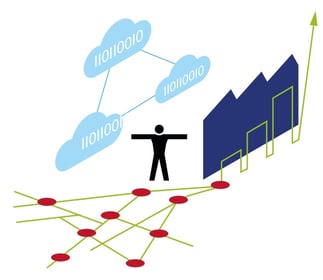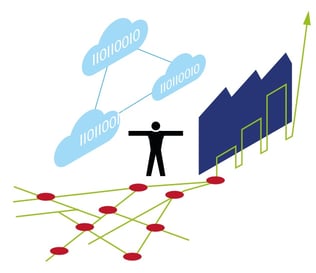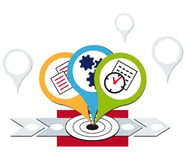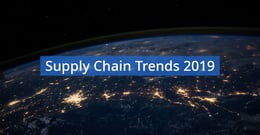What Features Should Your Supply Chain Management Software Have?
Brian Hoey - March 17, 2020

 In supply chain management, as with anything else, it can often be difficult to see past the hype and figure out which technologies are worthwhile and which aren’t. With things like cloud-based ERP, blockchain-based tracking, AI, and other buzzy new technologies flooding the SCM technology market in recent years, you might find yourself wondering what features and capabilities to prioritize when choosing a software vendor. Do you really need neural nets to analyze vendor performance in the cloud in real-time, or would you be better off leveraging your resources elsewhere?
In supply chain management, as with anything else, it can often be difficult to see past the hype and figure out which technologies are worthwhile and which aren’t. With things like cloud-based ERP, blockchain-based tracking, AI, and other buzzy new technologies flooding the SCM technology market in recent years, you might find yourself wondering what features and capabilities to prioritize when choosing a software vendor. Do you really need neural nets to analyze vendor performance in the cloud in real-time, or would you be better off leveraging your resources elsewhere?
Though every supply chain is different, most of them have similar foundations, and thus a similar set of basic needs. Keeping these needs in sight can give you some solid ground on which to build out towards more specific needs. After all, no one cares about the bells and whistles if your software solution can’t provide basic inventory planning functionality.
Standard SCM Software Features
Since there is, in fact, some basic functionality that virtually all supply chains needs, we can start by talking about the standard features that should form the baseline of any SCM software offering. If a provider can’t or won’t offer modules that cover this functionality, it may be a red flag.
- Inventory/warehouse management
- Billing and order management
- Transportation/logistics planning
- Vendor management, sourcing, and procurement
Naturally, these different functions all network together at different strategic planning levels, and once you’ve ensured that your SCMS can actually do all of these things you’ll want to make sure that there aren’t any data or planning silos hidden in the way the functionality is organized. This is to say that any software options you’re considering should demonstrate a high level of data and planning visibility and transparency. Why? Because end-to-end supply chain visibility is the only way to be absolutely sure that you’re managing costs and carrying out plans in a way that’s efficient, scalable, and not prone to disruption. If your inventory planners can’t tell what’s going on in your sourcing workflows, for instance, they won’t be able to use warehouse space efficiently; by the same token, if customer orders aren’t making their way to the planners in a timely way, your production plans aren’t going to be anywhere near optimal.
Thus, not only should your SCMS offer the functions listed above as a baseline, they should also offer some kind of end-to-end functionality that connects them—or at least keeps them visible. In this way, you make sure that anything new and fancy builds upon solid, preexisting value chain operations.
Advanced Analytics and Integrations
Okay, once all of the basics are out of the way, you can start considering what other features you need in order to optimize your supply chain operations. Again, this will vary from supply chain to supply chain: if you’re working with something as complex as the global automotive supply chain, you’ll seek out features that can help combat that complexity; if you’re a freight forwarder, you might be more interested in live tracking of shipments and containers. No matter the particulars, however, there are a few capabilities that could prove to a be a big help in your supply chain planning.
- Real-time data: In the standard functionality we talked about above, one of the most important parts of the equation was your ability to store and access data about different touchpoints on the value chain (i.e. warehouse information and transport routes). The logical next step when it comes to data management is to find features that empower real-time dataflows. This can take numerous forms, from live, IoT-powered streams of information from your shipping partners systems or your factory floor to resource planning modules that update automatically any time new information is entered anywhere else in the system.
- Advanced analytics: Of course, data is only as valuable as the uses you can finagle out of it—which is where advanced predictive and prescriptive analytics workflows come in. You can take that live flow of information and turn it into smarter forecasts and value chain optimizations. In a perfect world, this, too, would happen in real-time—meaning that any time a disruption arose you could create and implement a value-saving Plan B in a matter of minutes.
- Integration: Typically, software suites will offer specific modules for specific business functions, with the aim of creating a cohesive whole that functions at least as effectively as the sum of its parts. This means that any piece of software you’re considering should have some proven ability not just to network with other software from the same provider, but to interwork with your vendors’, logistics partners’, and even your customers’ IT. Not only does this help prevent rigid and inflexible ERP implementation (something that has caused huge disruptions for any number of companies), it further increases visibility and empowers agile, collaborative planning inter- and intra-operationally.
Choosing the Right Technology
We’ve gone over a number of features that you might want to look for in supply chain technology, but at this point you might still be wondering how, specifically, to go about choosing the right technology. For this, it’s important to start with a strong understanding of the specific needs of your supply chain. Ask yourself:
- What are the most common disruptions that impact your supply chain?
- What areas do you see as requiring the most improvement in performance (compared to areas that seem to be working well)?
- Which parts of the planning and execution processes are the most time and resource intensive?
- Where are there silos or instances of Shadow IT?
Based on the answers to these questions, you can see where your existing software ecosystem can be improved upon. For instance, if you have a robust S&OP infrastructure, but your actual quarterly plans still seem to get off track, you might prioritize solutions that have real-time transport pricing and inventory monitoring integrations, so that you can empower S&OE planners to keep those plans on track. In this way, you move one step closer to Industry 4.0-readiness, and one step further away from the old-school, inflexible, incident-prone supply chains of the past.
LATEST POSTS
- Understand Why Production Planning Needs Specialized Solutions
- Understand Circular Economy in The Manufacturing Industry
- How Can Industry 4.0 IT Integration Be Achieved Smoothly?
- The Significance of Order Sequencing in Discrete Manufacturing
- How to improve your Supply Chain Management: The Power of Control Towers



